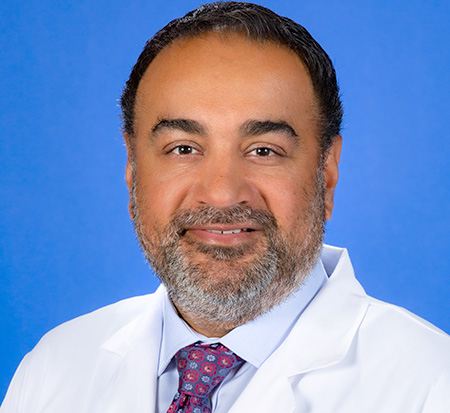Transcatheter edge-to-edge heart valve repair shows benefit for severe tricuspid regurgitation
Article in New England Journal of Medicine highlights minimally invasive procedure to repair leaky tricuspid valves
In an article published in The New England Journal of Medicine, UC Davis Health cardiologists shared promising findings from a recent clinical trial involving a heart valve procedure called transcatheter edge-to-edge repair (TEER). They found it was safe for patients with severe tricuspid regurgitation.
The article, published May 18, presented evidence that TEER reduced the severity of tricuspid regurgitation, and was associated with an improvement in quality of life for patients.

“Severe tricuspid regurgitation is a debilitating condition that is associated with substantial morbidity and often with poor quality of life,” said Gagan D. Singh, associate professor of cardiovascular medicine and co-author of the article. “The results from the trial showed TEER was highly effective in reducing tricuspid regurgitation and led to a meaningful improvement in quality of life after one year, without the high procedural risk often associated with tricuspid surgery.”
Tricuspid regurgitation is a condition where the tricuspid valve of the heart fails to close completely. This can allow blood to leak backward into the atrium from the tricuspid valve, causing the patient’s heart to pump harder to move blood through the valve.
Tricuspid regurgitation currently affects an estimated 1.6 million Americans. Symptoms include active pulsing in the neck veins, enlarged liver, fatigue and swelling throughout the body.
Current nonsurgical treatments for tricuspid regurgitation include diuretics (medicines that help remove excess fluid and salt) and drugs aimed at treatment of symptoms. Left untreated, tricuspid regurgitation can lead to atrial fibrillation, heart failure, kidney disease and even death.
Tricuspid transcatheter edge-to-edge repair procedure
For the trail, tricuspid TEER was performed with the TriClip Transcatheter Tricuspid Valve Repair system. It is the first device developed to fix the valve using a catheter instead of surgery.
While there is a catheter-based system for repairing the nearby mitral valve when it leaks, the tricuspid valve is trickier due to its location, thinness and variability.
The TriClip and its delivery system are designed specifically for the position, location and shape of the tricuspid valve. With the patient under general anesthesia, the device is delivered to the heart through a catheter, starting in the groin and guided by X-ray and ultrasound. Once in place, the clip brings together portions of the leaflets (flaps of the valve), improving the seal and reducing the leaking.
“Patients with tricuspid regurgitation are extremely high risk for any type of surgical intervention, so historically they have been monitored and treated with diuretics,” said Jason H. Rogers, professor of cardiovascular medicine and co-investigator for the trial. “This is the first study looking to fix the tricuspid valve using a minimally invasive procedure.”
Clinical trial results
During the clinical trial, called the TRILUMINATE Study, a total of 350 patients with symptomatic severe tricuspid regurgitation were enrolled at 65 centers in the United States, Canada, and Europe. They were randomly assigned to receive either TEER or medical therapy (control).
At UC Davis Medical Center, 34 participants were enrolled in the trial.
The results of the study showed:
- At 30 days, 87% of patients in the TEER group reached moderate or less tricuspid regurgitation compared with only 4.8% of the medical therapy group.
- During a 1-year follow-up, 88.9% of patients in the TEER group reached moderate or less tricuspid regurgitation, whereas 94.4% of patients in the medical therapy group were still classified as severe.
- The incidence of death or tricuspid-valve surgery and the rate of hospitalization for heart failure did not appear to differ between the groups.
“These results are very meaningful for a highly symptomatic population whose day-to-day life is impacted by tricuspid regurgitation,” Singh said. “Based on the results from the trial, this historically untreated population will have a new treatment option to improve their quality of life.”
Multidisciplinary effort
During the clinical trial, physicians, nurses, and staff from cardiovascular imaging, cardiothoracic surgery, advanced heart failure and the Heart and Vascular Center worked closely with Singh and the UC Davis Structural Heart team to complete the study.
“Dr. Singh and Dr. Rogers along with our entire clinical research team have been able to create an efficient pathway for impactful clinical trials, allowing us to perform well compared with other west coast academic medical centers”, said Thomas Smith, chief of cardiovascular medicine. “For nearly two decades, UC Davis Health has been a leader in transcatheter edge-to-edge repair — first with mitral and now with tricuspid — strengthening our reputation nationally as a premier structural heart center.”
Singh and his colleagues will continue to offer the Tricuspid TEER procedure to patients in a post-trial registry.



